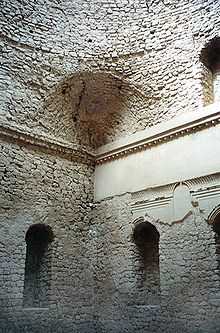Squinch

A squinch in architecture is a construction filling in the upper angles of a square room so as to form a base to receive an octagonal or spherical dome. Another solution of this structural problem was provided by the pendentive.
Construction
Squinches may be formed by masonry built out from the angle in corbelled courses, by filling the corner with a vise placed diagonally, or by building an arch or a number of corbelled arches diagonally across the corner.
History in the Middle East

The squinch was probably invented in Iran. It was used in the Middle East in both eastern Romanesque and Islamic architecture. It remained a feature of Islamic architecture, especially in Iran, and was often covered by corbelled stalactite-like structures known as muqarnas.
History in Western Europe
It spread to the Romanesque architecture of western Europe, one example being the Normans' 12th-century church of San Cataldo, Palermo in Sicily. This has three domes, each supported by four doubled squinches.
In Popular Culture
The science fiction novel Implied Spaces by Walter Jon Williams uses squinches as an example of parts of a structure whose construction is implied and made necessary to facilitate the construction of other parts; areas of a created world or universe which are implied (and thus created) as a by-product of the creation of other areas.[1]
Etymology
The word "squinch" comes from the Persian word "سه+کنج=) "سکنج) (pronounced sekonj). [citation needed]
See also
References
- ↑ http://www.baenebooks.com/chapters/1597801256/1597801256.htm?blurb | Implied Spaces at Baen Books
| Wikimedia Commons has media related to Squinches. |